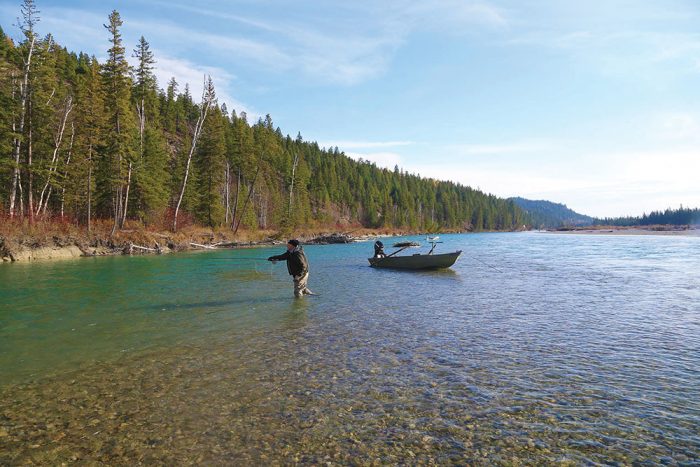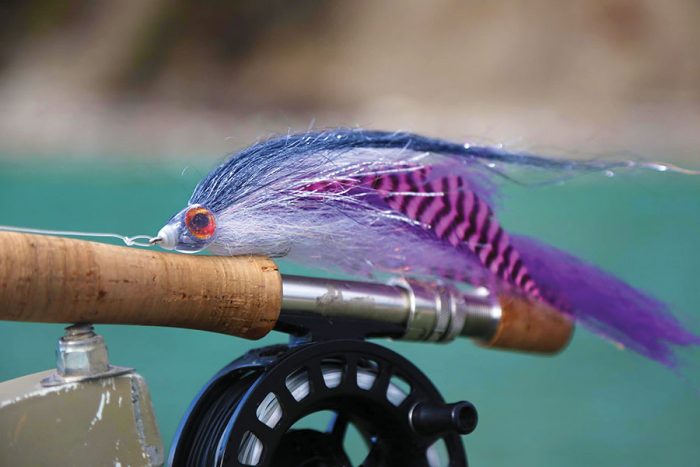By Cam Sigler Jr:
Back in 2014, I went north of the Canadian border to fish for bull trout and westslope cutthroat trout with Gordon Silverthorne, who owns the Kootenay Fly Shop in Fernie, British Columbia. This area west of Calgary is littered with good waters. I have taken large groups up to fish the Elk and surrounding rivers with him. It was on these trips that I found myself focused on catching bull trout. Big bulls on a fly became my quest. I had caught many, up to nine in a day, but had yet to break the 27-inch mark.
Bull trout are in the char family with brook trout and Dolly Varden. They range from northern parts of California and Nevada in the south to the Northern Territories of Canada and East to Montana and Alberta. They can grow in excess of 40 inches long and to weights heavier than 30 pounds. They migrate up and down systems based on food sources and into feeder creeks to spawn. They typically inhabit waters that stay under 59 degrees and are one of the most sensitive of the chars, requiring pristine waters to thrive. They are recognized as endangered in most states and protected in most systems in the provinces. A bull trout of 12 pounds might be 10 years old.
I was back in Fernie in 2015 chasing trout with a few friends. As usual, we had good fishing for beautiful cutthroats, but I was chasing bulls. We spent a few days on the Elk River and caught a few bulls longer than 20 inches, but not in great numbers.
My attention turned to a small pristine river south of Fernie called the Wigwam. In the past I had sent anglers from my groups there, but because of limited daily access, I had not fished it myself. Access is difficult. From the parking area, it’s 800 feet down to the river. It’s a hang-onto-trees steep. It reminded me of some streams I guided in Alaska, cold and clear enough to see pebbles 20 feet deep. The first hole was full of bull trout. After many casts, I landed one longer than 30 inches. As a group, we caught many cutts that averaged about 16 inches and juvenile bulls of the 19-inch variety.
In conversation, Gordon spoke of the nearby Kootenay River bull trout fishery and about setting up an operation there. The Kootenay is a glacial-fed river formed by runoff and feeder streams primarily out of Kootenay National Park above Cranbrook, Canada. I told him to count me in for an expedition that fall. It didn’t happen because of a landslide in the river’s headwaters that blew the river out for an entire season. It’s tough to fish a fly without visibility. Because of water levels and clarity, the window for fly fishing the Kootenay is about six weeks in fall, if you are lucky.
I finally got my chance to fish it in late October of 2016. Author Tom Boyd, who is writing a book on all the char species, and I made the 6-hour drive north from my second home in Washington to a tent camp Gordon and big-game outfitter Eric Grinnell had erected on the river. The camp was great, complete with a stove in every tent and a generator for lights. It was located a good distance between put-in points, and we saw only four other boats over three days.
The four of us had a terrific time. We saw a few deer on the river and kept an eye out for grizzly and black bears but saw no evidence of them. I did wake one night to the sound of wolves howling in the distance. Water levels dropped over the three days we fished, and the water cleared even more. The weather was clear and cold.

This is a 7- to 9-weight show with sink tips. I have caught many bulls dead drifting a rabbit strip or synthetic-based fly that swims with this method. This trip, stripping seemed to work the best. We were on the tail end of the kokanee salmon spawn. Once spawned out, these landlocked sockeye salmon float downriver, and the bull trout key on the spent fish. So we threw lots of 10-inch flies.
Bull trout are very aggressive and opportunistic. They have to be in these systems. Bulls can move daily, but once we found them in a section they readily took most flies we threw. Bull trout, like many trout, like structure. Snags, logs, and big rocks in the river often hold them.
I caught the biggest fish of our trip on the last cast of the last day in a tail out. It topped 29 inches and took a crawfish pattern I tie for smallmouth. We caught a few juvenile bulls in the 19-inch range and a few cutthroat, but our average bull trout was about 23 inches. I saw a few fish that were clearly bigger than our biggest catch. My guess is there are bulls in the Kootenay pushing the 40-inch mark. The largest we heard of on a fly weighed about 30 pounds.
The bull trout fishery in the U.S. and Canada is fragile. I suggest chasing them sooner than later. If you decide to fish the Kootenay next fall, look for the guy holding up the 35-inch fish. Hopefully that’s me, as I will keep going back.
For information or to set up a trip, contact Gordon Silverthorne at info@kootenayflyshop.com.

